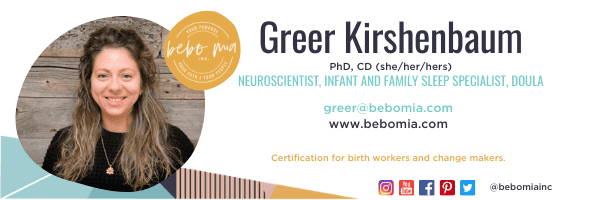[wpseo_breadcrumb]
Bedsharing with Baby
It has only been for the past 100 years or so that parenting culture in the west – especially Canada, The United States, The United Kingdom and Australia – has been heavily influenced to expect babies to sleep independently. Caregivers expect babies to sleep in their own room in a crib, all alone, for many hours. Our culture sees it in best selling books, in movies, on television and in advertising. We are influenced by a booming industry of sleep training and sleep accessories dedicated to this elusive goal – babies sleeping alone.
We have been conditioned to believe that babies who sleep alone are ‘good babies’ and parents who can make that happen are ‘good parents’.
As a result, most caregivers are obsessed with infant sleep in general, the idea of a baby sleeping alone and they struggle hard to make it happen. Caregivers spend tons of mental energy worrying about sleep schedules, they spend lots of money trying to fix sleep problems (the real problem is you’re fighting biology). Parents often feel like they are failing if their baby has trouble sleeping alone. Along the way caregivers can get stressed out, babies can get stressed out and the caregiver infant relationship can be strained. There are some babies that happily sleep alone, but they are very rare.
Most babies sleep unhappily alone.
An uphill battle for independent sleep is clearly not working for anyone and when we understand the infant brain, this is not surprising. The truth is our culture has been influenced by a belief and not by scientific evidence. For the past 100 years or so we’ve been working against the biology of babies. Science teaches us that babies sleep better when they are not alone; they sleep better when they sleep together or close to a caregiver. What They Aren’t Telling You About Bedsharing with baby
Research shows us that babies’ brains are primed to sleep when they are close to a caregiver. Babies have evolved sleeping with their primary parent for over 200 000 years. When close, babies’ brains receive signals from caregivers to facilitate sleep. When we ask babies to sleep alone, we are asking them to sleep without any helpful caregiver signals. For many babies this is an impossible task. It is not surprising that many sleep gadgets have the goal of convincing a baby that a caregiver is close.
Babies and children eventually develop the brain skills for independent sleep: to fall asleep and stay asleep on their own. These skills are not something we can train or force. By pushing these skills when an infant is not ready can trigger other processes in the brain like stress, fear and anxiety. When we support infant sleep biology and sleep close to infants, we are supporting the development of independent sleep. It’s important to remember that, as we age, we still enjoy sleeping close to other people. The signals we receive from others make us feel safe, regulated, calm and sleepy.
When we support infant sleep biology and sleep close to infants, we are supporting the development of independent sleep. Meaning we are helping NOT hindering them from learning to sleep on their own.
What They Aren’t Telling You About Bedsharing
Keeping safe bedsharing information out of the hands of new parents is dangerous.
Sleeping close together for a baby means co-sleeping which is sleeping safely in a bassinet or crib in the same room as a caregiver (preferably right beside a caregivers’ bed). Sleeping close can also mean bedsharing which is sleeping safely in a caregivers’ bed that has been modified for a baby. It can also be a hybrid of co-sleeping and bedsharing where a baby sleeps safely in a sidecar crib, a crib that is continuous with the caregiver’s bed. In any case, caregivers must be responsible to maintain a safe sleep environment.
What we know from working with parents on the ground level, is that they are not getting the proper information when it comes to safe sleep, leaving them open to unsafe practices. For example, trying to stay awake while holding the baby on the sofa, in spite of being exhausted and at risk for falling asleep or bringing the baby to bed with them without knowing if their environment is properly set up for safe bedsharing. Infant and Family Sleep Training, trained by bebo mia, is a wonderful resource to create a safe sleep space for a baby.
The current infant sleep recommendations from the American Academy of Pediatrics and The Canadian Paediatric Society say it is safest to co-sleep, meaning to have a baby in the same room as caregivers on a separate sleep surface for at least 6 months and the AAP says ideally up to 12 months. These recommendations also include daytime sleep aka naps. Even if a family never plans to bedshare, every family should know how to bed share safely. Very often there are nights and naps when a baby needs to be very close to a caregiver to sleep and we want it to be done safely every time.
What They Aren’t Telling You About Bedsharing
Infant and Family Sleep TrainingSleeping with baby
Now, let’s take a look at why babies are happy when they sleep close to a caregiver.
Firstly, babies’ brains get the following signals from the company of a caregiver:
- Smell and pheromones
- Sound of breathing
- Sound of heartbeat
- Sight
- Touch
When a baby’s brain senses these signals from a caregiver, babies feel safe and relaxed, which is ideal for sleep.
The caregiver signals listed above do the following:
Relax the nervous system
In order to sleep, babies need the parasympathetic or ‘rest and digest’ nervous system. When the parasympathetic nervous system is active, the energy in our bodies is directed to relax, repair and nourish our organs.
Regulate the stress hormone cortisol
To sleep, the stress hormone cortisol needs to be low. When infants are close to a caregiver, their stress response and cortisol is blunted and regulated.
Indicate safety
Babies need to feel safe to enter the vulnerable brain state of sleep. The scents, sounds and touch of a caregiver provide a baby with constant safety signals. Even when we grow up, the scent of a caregiver from infancy is a safety signal.
Induce a relaxed brain state
A caregiver’s relaxed or sleeping brain influences a baby’s brain to be relaxed.
Influence physiology
A caregiver regulates a baby’s breathing, heart rate, blood oxygen, and blood glucose which are comfortable for sleep.
…
Our wish is for all caregivers to expect and understand that they and their baby benefit tremendously when they sleep close together. No family should feel pressured to spend another second forcing babies to sleep alone, because the more we sleep together, the happier we’ll be. Check essential for sleep
If you want to dive a little deeper into this information you can check out our most recent interview with Greer!
https://www.instagram.com/p/CZrtY4yrWi9/
xoxo,
Dr. Greer Kirshenbaum Phd,
The Neuroscientist Doula, is on a mission to revolutionize the future of health by communicating scientific research. Greer worked in neurobiology laboratories for over 18 years studying how genetics and experience shape the emotional brain and influence lifelong mental and physical health. She has published numerous academic research articles and received many awards.
Dr Greer Kirshenbaum PhD is a neuroscientist, infant and family sleep specialist and doula. Greer has a BSc in Neuroscience from Dalhousie University and a PhD in Medical Science and Neuroscience from the University of Toronto.
Greer teaches families and perinatal practitioners to understand how caregivers can boost success for their infants. By shaping babies’ brains through simple intuitive enriching experiences in pregnancy, birth and infancy. Greer teaches courses, holds workshops, provides consultations in pregnancy and infancy and is a birth and postpartum doula.
You might also like:
Sorry, we couldn't find any posts. Please try a different search.

FREE ONLINE MINI-COURSE
BLISS IN BUSINESS RETREAT
Your future is created by what you do today — that's why we created a completely FREE mindset mini-course to help doulas and birth workers find bliss in their business!




I loved this article, but I was confused why an article about safe co sleeping included a photo of a baby in a sleep nest. Yes, the parent is awake in the photo, but I find this misleading. I sleep deprived mother may not make that assessment and use such a device for un supervised sleep. I hope you might consider changing it for a photo of safe co sleeping
Hello Jenny! Thank you very much for the heads up, we really apreaciate it. We are glad you loved this article and found it helpful. We have already updated the image 😉